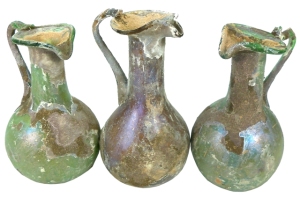 Little is known about the production of glass in the ancient world. One early source, Pliny the Elder (AD 23 – 89), reported the tale of natron (soda) merchants who, when they stopped to prepare a meal, supported their cooking vessels on the beach with blocks from their cargo. The heat of the fire fused natron and sand, and a new substance was formed. This, Pliny says, was the origin of glass.
Little is known about the production of glass in the ancient world. One early source, Pliny the Elder (AD 23 – 89), reported the tale of natron (soda) merchants who, when they stopped to prepare a meal, supported their cooking vessels on the beach with blocks from their cargo. The heat of the fire fused natron and sand, and a new substance was formed. This, Pliny says, was the origin of glass.
Glass-like materials were used in Egypt long before the production of glass itself. Egyptian faience, a popular material used in the production of amulets and small vessels, was a mixture of quartz sand with an alkali binder. It was molded, and then fired, causing a bright glaze to migrate to the surface. Real glass is more difficult to produce, because its ingredients must be heated to a high enough temperature to melt and then fuse completely. Mesopotamian cuneiform tablets contain some references to glass making, indicating that it was a very difficult and secret undertaking. There is no ancient recipe for the making of glass, but it may be that in an attempt to duplicate the glazes formed in pottery making, the mixture of sand, soda and lime bonded compatibly, thus forming the 4,000 year old lump of blue rod found near Eshuna, which dates from 2,000 BC, is the earliest glass that has been found.
In about 1,500 BC, the technique of “core forming” developed in both Egypt and Mesopotamia. This new method was an important breakthrough in glass making. It was a technique that remained in use for over a thousand years, allowed for the production of glass vessels in a thousand years, and allowed for the production of glass vessels in variety of shapes. A core of mud of about the same size as the completed vessel was placed on the end of an iron rod. A second rod was dipped into containers of colored molten glass, and the glass was wound around the core material. This process was repeated many times until the core was covered. The next step was to wind bands of colored glass around the core glass and to comb them into a design. The final additions – the rim, the base and may be the handles – were added last. The piece was slowly cooled and then polished. It was a lengthy and expensive process, and core-formed glass was available only to rulers and nobility.
The Millefiori technique (Italian for “a thousand flowers”) was also known in Mesopotamia as early as 1500 BC. This method required a group of various colored glass rods to be placed in a cylindrical mold. They were heated and fused together, and were then pulled from a small tube, like taffy. This created a pattern that was then sliced and placed side by side into a decorative mold, in order to create the final shape. This method too was expensive and time consuming to produce and its colorful patterns were again available only to the wealthy.
Glass blowing was probably the greatest single advance in glass technology. This revolutionary process was discovered around the middle of the first century BC and seems to have been practiced from the first century AD on. It involved capturing a molten glass bubble on a hollow metal blowpipe and inflating it to the desired shape and size. It could be either blown free form or blown into a mold, or a combination of two. The speed and relative ease with which this technique could be handled opened new vistas for the production and use of glass in the ancient world.
Glass blowing developed at a time when the Roman Empire, under Augustus Caesar and his successors, wanted peace (Pax Romana), stability and a better way of life, and this included consumer goods. The combination of a new technology and a demand on the part of the Roman citizen allowed the new method to forge ahead, and blown glass began to rival pottery and metalwork, both in speed of production and in variety of shapes and sizes. Its smooth surface was easy to clean for reuse, eliminating the storage problem of porous pots.
Syria became the “glass factory” of the Roman Empire, and goods were shipped and stored in glass bottles and wine flowed from glass jugs. Blown glass was finally inexpensive and available to all.
Today, many examples of ancient Roman Glass are available to collectors. Unguentaria or “tear bottles”, as they are often called, are the most common items of Roman blown glass. They vary in size, but usually have a somewhat bulbous base with a long slender neck and a flat rim. The color varies from colorless to pale blue/ greenish hues, and they sometimes are covered with an iridescent patina. Unguentaria were used for perfumes, cosmetics, and oils, and are fine examples of ancient glass that can be collected today.
